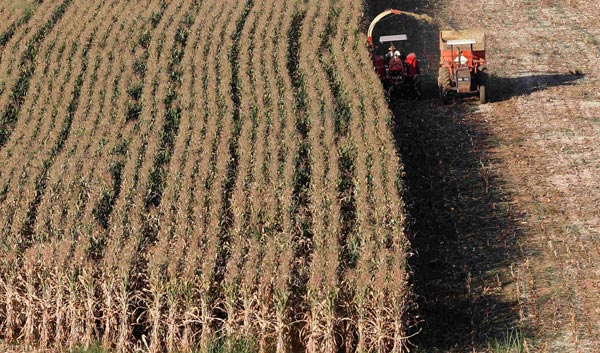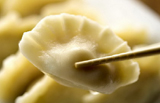China lifting GM corn ban a boon to growers
Updated: 2014-12-22 04:49
By JACK FREIFELDER in New York(China Daily Latin America)
|
||||||||
|
 |
|
Tall feed corn is harvested on a warm summer day in Santo Antonio do Jardim in February. Paulo Whitaker / Reuters |
Big 'obstacle' removed but worries on domestic surpluses remain
China's lifting of a ban on imports of a genetically modified strain of corn and corn byproduct is welcome news for the world's major growers of corn, from the United States to Brazil and Argentina, but trade to China will still be muted by domestic surpluses, according to analysts.
Shawn McCambridge, a senior grains analyst at Jefferies Bache Commodities in Chicago, said that last week's lifting of a ban on Syngenta AG's MIR162, an insect-resistant variety of corn, removes an "obstacle" between the United States and China.
"The decision to lift the ban removes an obstacle that had basically shut off corn imports from the US, not only on corn but also eventually on DDGs (dried distillers grains)," McCambridge told China Daily. "This is something that could have had a long-term effect if the ban had not been lifted.
"China is facing huge stockpiles of corn right now that they have to deal with domestically, and these supplies are very highly priced relative to the imports that could be brought in," he said.
As a result, China's effort to "diversify its origination base" amid continued biotechnology hang-ups with American producers helps reduce the country's risk of overreliance on a single supplier, McCambridge said.
"From China's perspective, you want as many origins as possible: Brazil, Argentina, Ukraine, Russia, US, etc," he said. "And more origination means better price competition."
John Payne, a market analyst with Daniels Ag Services, said producers of corn-based ethanol may see the biggest bump from the resumption of corn trade between the US and China.
"Demand for corn still exists [in China], and prices tend to run a lot of things, but the real winner would be the DDG producers on the ethanol side," Payne said. "The byproduct of ethanol is DDGs, which are a big input for feed. That's what China tends to import, and that may be something that starts to open things up here."
Late last year, China began rejecting corn shipments from the US after it found traces of the MIR162 biotech variety. Bloomberg News reported on Dec 18 that China has turned away more than 1.2 million tons of US corn and corn products, according to estimates from Sylvia Shi, an analyst at agriculture consultancy Shanghai JC Intelligence.
Dozens of US farmers have sued Syngenta over MIR 162, claiming the seedmaker misled the farm industry about the timeline for approval from China. The strain is also approved and planted in Brazil and Argentina, according to the Iowa Corn Growers Association (ICGA).
In March, China's General Administration of Quality Supervision, Inspection and Quarantine (AQSIQ) approved sizable imports of corn from Brazil, lessening its dependence on US corn imports.
The agreement with Brazil was similar to deals with Argentina in February 2012 and Ukraine the following November. Analysts said then that the deals were likely the result of several months of work to agree on the kinds of Brazilian corn that China would accept for import.
In November, Brazil's agriculture minister, Antonio Andrade, told reporters that the two countries had reached a phytosanitary agreement — a technical document that sets out the terms of pest- and disease-free plant imports — but hadn't said when it would be formally approved.
Brazil is the world's second-largest corn exporter after the US, and Argentina is third.
"Brazil has certainly come on the world stage for corn, but the US is still going to be the buyer of last resort when it comes to world corn," said Payne, with Daniels Ag Services. "Not only because the US has the farmers who harvest corn, but also because we have the infrastructure to move it."
Brazilian corn imports give the world's second-largest economy an alternative source to US-produced grain, and also affords international growers the opportunity to increase dialogue with Chinese agriculture authorities, according to Nathan Fields, director of biotechnology and economic analysis for the National Corn Growers Association (NCGA).
"What this means from an agricultural standpoint is that US grains will apparently be able to be imported into China again," Fields told China Daily. "Politically speaking, it's a very positive move. There's more than just the impact on corn here. It goes beyond that, and really helps out the whole agricultural economy."
"Generally speaking, the South American growers want access to technology, too, because it makes their agriculture more efficient," he said.
jackfreifelder@chinadailyusa.com
Most Viewed
Editor's Picks

|

|

|

|

|

|
Today's Top News
Awaiting word from China on Sony hack
Learning about 'Americanness' from Chinese-American vets
Alibaba IPO fuels startup boom to rival Silicon Valley
China's top Party offcial probed for disciplinary violations
No judgment yet on Sony
US arms sales to Taiwan protested
Chinese developer buys LA Marriott
Beijing seeks new tourism spotlight in New York
US Weekly

|

|















